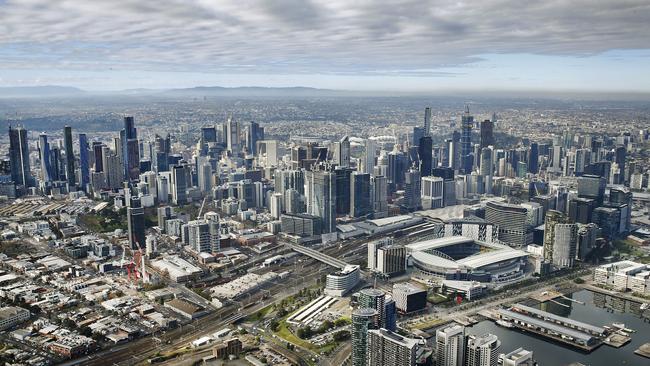Melbourne leads growth charge as Aussies can’t escape the urban jungle
Our population is expected to continue to increase; the task will be distributing more of it outside capital cities.

With a new decade at our doorstep, it’s time to review the 10 years behind us. Population growth was the dominating demographic topic. We expanded our population base because our economy was hungry for skilled workers and our universities attracted international students. One in six international students ends up staying as a skilled migrant. Population growth and the changing nature of work are inextricably linked.
Overall, we added more than 3.4 million people since 2010 — 1000 new residents every day for a decade. Melbourne grew much faster than Sydney — another two decades like the 2010s will make Melbourne our largest city. All capitals saw impressive growth rates. We tend to belittle Adelaide as a slow-growing city but a growth rate of 8 per cent stacked up nicely internationally in a decade where London grew by 14 per cent, Berlin by 3 per cent and the mighty New York by 2 per cent.
Not all parts of Australia added population. While all large cities grew, many rural and regional towns experienced population decline and attracting new residents remains a pressing issue. Why did we move to large cities and why did we shun regional Australia?
A demographic truism proclaims that population growth follows job growth. We move where the jobs are. The jobs we added in the past decade are clustered in the central business districts of our largest cities while the declining jobs were concentrated in the regions and urban fringes.
As an ageing but wealthy nation we can provide for our elderly. This explains why health was the strongest growth sector. While healthcare jobs spread somewhat evenly across the continent, they do tend to show soft clustering patterns in the medical precincts of our larger cities. However, the second and third largest growth industries, professional services and education, heavily cluster in the centres of our largest cities.
Farm aggregations and technological advances ensured fewer workers were needed in the regions. Small towns needed to be innovative to counteract the population shrinkage. Many small towns in the orbit of our capital cities reinvented themselves as lifestyle towns targeting sea-changers and tree-changers.
Here we come to two popular demographic predictions made at the start of the 2010s that didn’t eventuate as we expected. The first prediction regarded the initial wave of retiring baby boomers. The kids moved out, retirement loomed, the house is worth a bucketload, but boomers didn’t downsize as we expected. Baby boomers could’ve sold their large home, bought a smaller property in a quiet sea-change town and pocketed the difference. This didn’t happen at any meaningful scale.
Instead they prefer to live in their home for as long as they are physically independent. That’s their right, of course. It meant, however, that younger generations, whose jobs are clustered in the inner cities, had to move farther out to find housing large enough for a family, and commutes became longer. The painful experience of commuting (happiness research shows nothing makes us as unhappy as travelling to work by car or unreliable public transport) was intensified by the fact infrastructure upgrades didn’t keep pace with population growth in the 2010s.
The second prediction error regarded the number of Australians working remotely. By 2010 we had iPhones and were excited about working remotely. We expected jobs to escape the confinement of inner-city office towers. People would work from the comfort of home. We’ve seen a small increase in people working from home but not large enough to seriously ease the pressure on our transport networks. Software made many boring repetitive work tasks more efficient or even got rid of them completely. Tasks left for human office workers have become more interpersonal and communicative, best done face to face.
At the start of the 2020s we make similar predictions as at the start of the 2010s. Sure, boomers are downshifting, but the movement is comically over-estimated. Regarding moving jobs out of offices into homes, I would argue that the office market will not be adversely affected. Office workers will increasingly work a day or two from home but will continue to go to their office. Companies are already responding to this trend by switching to hot-desking arrangements. Knowing a certain percentage of their staff work from home any given day allows them to get away with providing smaller offices. Most important, population growth in the 2020s will be used much in the same way as in the 2010s. Increasing the base is a simple way of growing the economy and no treasurer will want to give up on such a tool. The biggest demographic challenge will be to channel some of our national population growth from the capital cities to the regions.
Simon Kuestenmacher is the co-founder and director of research at The Demographics Group.



